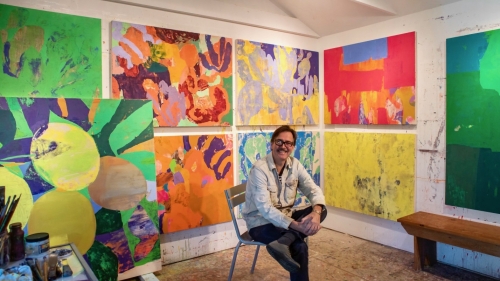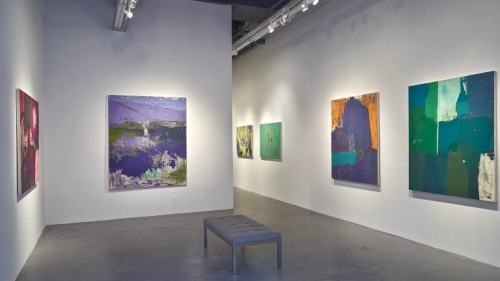
Eric Dever in his Water Mill, New York studio.
Eric Dever (MA ’88) is a painter who graduated from NYU Steinhardt’s studio art program.
His paintings are part of notable public collections at the Parrish Art Museum, Grey Art Gallery-New York University Art Collection, Guild Hall, East Hampton, New York, and Centre d’Art et de Culture, Saint Just de Bellengard, France. He was in the permanent collection exhibition, Parrish Perspectives: Art in Context at the Parrish Art Museum, Water Mill, New York, and on display at the Hudson River Museum in Yonkers, New York. We spoke to him about his artistic process.
You paint in New York City and the East End of Long Island. How do these locales influence your work?
My painting during graduate school, 1986-88, was influenced by urban landscape and physical forms of civilization. New to town from Los Angeles, I spent a lot of time in museums and was fascinated walking around the city and boroughs. My paintings were often elegiac; the AIDS crisis concerned everyone. The city was very exciting, one had the sense that anything could happen, and each day held life-changing possibilities.
Since 2003, I have worked on the East End of Long Island. It is always exciting to move to a new place and my paintings reflected this change. I began with sampled color from a new landscape, but soon moved towards a more personal experience which space and contemplation seemed to permit.
Working with just white paint for four years gave me a heightened awareness of my material. Canvas, linen, paint media—painting itself became the subject of my work. The addition of black and red corresponded over time with an increasing awareness of the subtle qualities of ‘Clarity, Passion and Dark Inertia’ (exhibition NYU Kimmel Galleries, 2015), or the 3 gunas, a key aspect of yogic studies, and a means of interpreting nature itself.
How does color inform your creative process?
During the last three years, I have begun an investigation into the full color spectrum, the subject of my exhibition at Berry Campbell Gallery, New York, perhaps retracing some of my earlier steps, building on everything I have learned with this ‘personally’ new color palette.
But, again, I find myself taking cues from the environment.
A blossom, color or palette, which reflects a season is often the beginning of a painting. I layer the canvas with imprints of color, washes; paint applied with knives and brushes, part of the completion of a painting as an experience or something that needs to come into focus.

Eric Dever’s work is on view at Berry Campbell Gallery in New York City.
Could you tell me what a typical work day is like for you?
I usually work on several paintings at the same time and include new ones as others are tentatively finished, and so the studio is always in a form of perpetual motion. I have a good idea each day of what I’d like to do, see, or try. And of course the results are usually unexpected, sometimes frustrating, begging new questions, but this is part of the excitement of the new. From time to time, it is necessary to build, prime, and stretch new canvases, or prepare and wrap work for an exhibition. This can take a few days and is somewhat tedious, but I listen to music and look at what is up on the walls and think about it. Ordinarily I spend a lot of time looking at my paintings and then put them away for months.
Who were your teachers at NYU in 1988, and how did they influence you?
The NYU Steinhardt faculty reflects the dynamism of our times. Painter Marcia Hafif offered us a thoughtful way forward through a period that characterized ‘painting as dead’ as well as ‘post modernism.’ A visit to her studio, where she was grinding pigments and working through a single medium at a time, often monochrome, became a powerful and lasting influence on my own work.
Peter Campus, a pioneer of new media, presented new ways of working in photography, film, and video, transcending in each instance our experience or expectation in meaning.
Carolee Schneemann revealed that an investigation into life itself, across platforms, could be art: painting, photography, film, writing, and all at once.
What advice do you have for a young artist?
I’ve had some good mentors. Peter told me that it is important to take a long view. He honed his skills commercially and has gone on to break the rules going forward. Marcia developed a way of working, reductive in nature, that is both highly personal and universal. Both artists have been interested in different spiritual practices, Tai chi and Zen Buddhism; I think this helped them find a quiet or still place which informs their work.
My advice? Work as much as you can and take care of yourself; this is really the same thing. Make time to work and think of this broadly: write in the morning, read on public transportation, see an exhibit on a lunch break, make a study of film, always take pictures; paint at night, on your day off, and on holidays.
Cumulatively this adds up, and one day you will see your mark on the work, the thread that is woven through your life.
